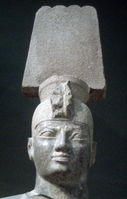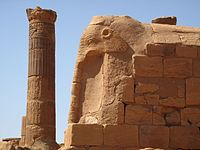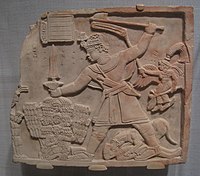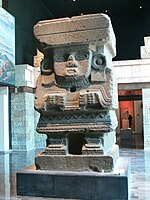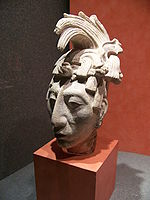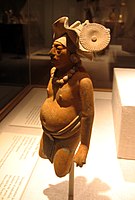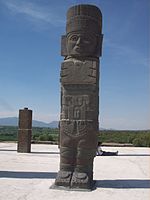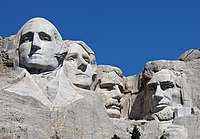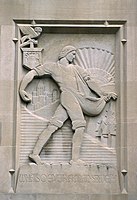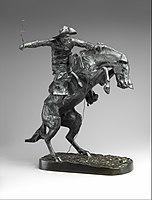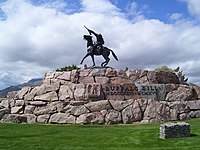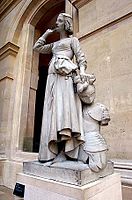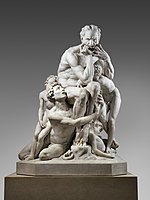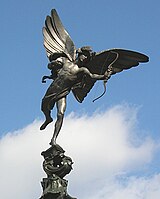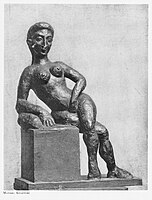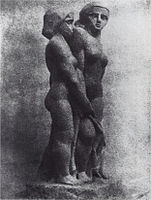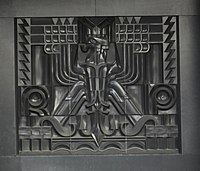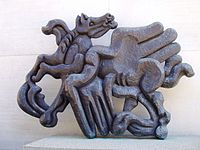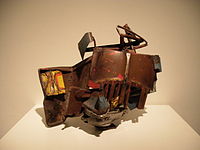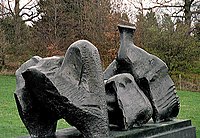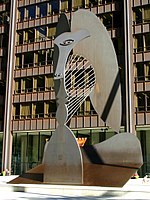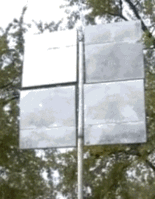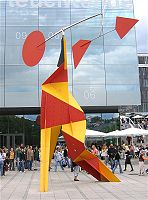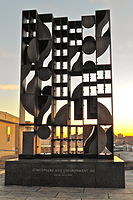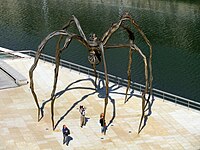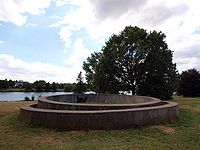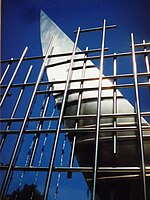Sculpture
This article contains too many pictures for its overall length. |
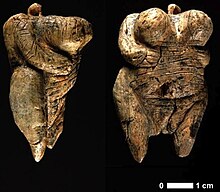

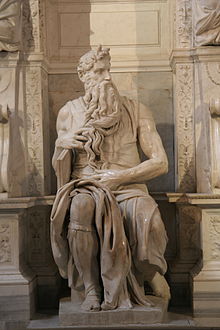
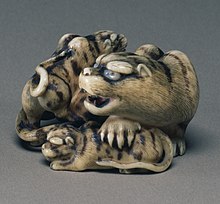
Sculpture is the branch of the
Sculpture in stone survives far better than works of art in perishable materials, and often represents the majority of the surviving works (other than pottery) from ancient cultures, though conversely traditions of sculpture in wood may have vanished almost entirely. However, most ancient sculpture was brightly painted, and this has been lost.[2]
Sculpture has been central in religious devotion in many cultures, and until recent centuries, large sculptures, too expensive for private individuals to create, were usually an expression of religion or politics. Those cultures whose sculptures have survived in quantities include the cultures of the ancient Mediterranean, India and China, as well as many in Central and South America and Africa.
The Western tradition of sculpture began in ancient Greece, and Greece is widely seen as producing great masterpieces in the classical period. During the Middle Ages, Gothic sculpture represented the agonies and passions of the Christian faith. The revival of classical models in the Renaissance produced famous sculptures such as Michelangelo's statue of David. Modernist sculpture moved away from traditional processes and the emphasis on the depiction of the human body, with the making of constructed sculpture, and the presentation of found objects as finished artworks.
Types

A distinction between sculpture "in the round", free-standing sculpture such as
Another basic distinction is between subtractive carving techniques, which remove material from an existing block or lump, for example of stone or wood, and modelling techniques which shape or build up the work from the material. Techniques such as casting, stamping and moulding use an intermediate matrix containing the design to produce the work; many of these allow the production of several copies.
The term "sculpture" is often used mainly to describe large works, which are sometimes called monumental sculpture, meaning either or both of sculpture that is large, or that is attached to a building. But the term properly covers many types of small works in three dimensions using the same techniques, including coins and medals, hardstone carvings, a term for small carvings in stone that can take detailed work.
The very large or "colossal" statue has had an enduring appeal since antiquity; the largest on record at 182 m (597 ft) is the 2018 Indian Statue of Unity. Another grand form of portrait sculpture is the equestrian statue of a rider on horse, which has become rare in recent decades. The smallest forms of life-size portrait sculpture are the "head", showing just that, or the bust, a representation of a person from the chest up. Small forms of sculpture include the figurine, normally a statue that is no more than 18 inches (46 cm) tall, and for reliefs the plaquette, medal or coin.
Modern and contemporary art have added a number of non-traditional forms of sculpture, including
Purposes and subjects
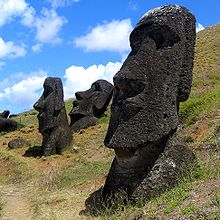
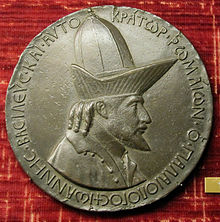
One of the most common purposes of sculpture is in some form of association with religion.
Small sculptures as personal possessions go back to the earliest prehistoric art, and the use of very large sculpture as
The totem pole is an example of a tradition of monumental sculpture in wood that would leave no traces for archaeology. The ability to summon the resources to create monumental sculpture, by transporting usually very heavy materials and arranging for the payment of what are usually regarded as full-time sculptors, is considered a mark of a relatively advanced culture in terms of social organization. Recent unexpected discoveries of ancient Chinese Bronze Age figures at Sanxingdui, some more than twice human size, have disturbed many ideas held about early Chinese civilization, since only much smaller bronzes were previously known.[4]
Some undoubtedly advanced cultures, such as the
The collecting of sculpture, including that of earlier periods, goes back some 2,000 years in Greece, China and Mesoamerica, and many collections were available on semi-public display long before the modern museum was invented. From the 20th century the relatively restricted range of subjects found in large sculpture expanded greatly, with abstract subjects and the use or representation of any type of subject now common. Today much sculpture is made for intermittent display in galleries and museums, and the ability to transport and store the increasingly large works is a factor in their construction.
Small decorative
Portrait sculpture began in Egypt, where the Narmer Palette shows a ruler of the 32nd century BCE, and Mesopotamia, where we have 27 surviving statues of Gudea, who ruled Lagash c. 2144–2124 BCE. In ancient Greece and Rome, the erection of a portrait statue in a public place was almost the highest mark of honour, and the ambition of the elite, who might also be depicted on a coin.[5]
In other cultures such as Egypt and the Near East public statues were almost exclusively the preserve of the ruler, with other wealthy people only being portrayed in their tombs. Rulers are typically the only people given portraits in Pre-Columbian cultures, beginning with the Olmec colossal heads of about 3,000 years ago. East Asian portrait sculpture was entirely religious, with leading clergy being commemorated with statues, especially the founders of monasteries, but not rulers, or ancestors. The Mediterranean tradition revived, initially only for tomb effigies and coins, in the Middle Ages, but expanded greatly in the Renaissance, which invented new forms such as the personal portrait medal.
Animals are, with the human figure, the earliest subject for sculpture, and have always been popular, sometimes realistic, but often imaginary monsters; in China animals and monsters are almost the only traditional subjects for stone sculpture outside tombs and temples. The kingdom of plants is important only in jewellery and decorative reliefs, but these form almost all the large sculpture of Byzantine art and Islamic art, and are very important in most Eurasian traditions, where motifs such as the palmette and vine scroll have passed east and west for over two millennia.
One form of sculpture found in many prehistoric cultures around the world is specially enlarged versions of ordinary tools, weapons or vessels created in impractical precious materials, for either some form of ceremonial use or display or as offerings.
Materials and techniques
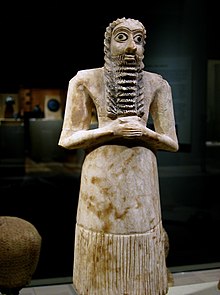
The materials used in sculpture are diverse, changing throughout history. The classic materials, with outstanding durability, are metal, especially bronze, stone and pottery, with wood, bone and antler less durable but cheaper options. Precious materials such as gold, silver, jade, and ivory are often used for small luxury works, and sometimes in larger ones, as in chryselephantine statues. More common and less expensive materials were used for sculpture for wider consumption, including hardwoods (such as oak, box/boxwood, and lime/linden); terracotta and other ceramics, wax (a very common material for models for casting, and receiving the impressions of cylinder seals and engraved gems), and cast metals such as pewter and zinc (spelter). But a vast number of other materials have been used as part of sculptures, in ethnographic and ancient works as much as modern ones.
Sculptures are often painted, but commonly lose their paint to time, or restorers. Many different painting techniques have been used in making sculpture, including tempera, oil painting, gilding, house paint, aerosol, enamel and sandblasting.[2][6]
Many sculptors seek new ways and materials to make art. One of
Stone
The copying of an original statue in stone, which was very important for ancient Greek statues, which are nearly all known from copies, was traditionally achieved by "pointing", along with more freehand methods. Pointing involved setting up a grid of string squares on a wooden frame surrounding the original, and then measuring the position on the grid and the distance between grid and statue of a series of individual points, and then using this information to carve into the block from which the copy is made.[8]
Metal
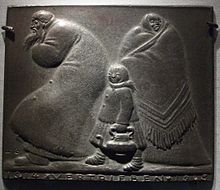
Casting is a group of manufacturing processes by which a liquid material (bronze, copper, glass, aluminum, iron) is (usually) poured into a mould, which contains a hollow cavity of the desired shape, and then allowed to solidify. The solid casting is then ejected or broken out to complete the process,[9] although a final stage of "cold work" may follow on the finished cast. Casting may be used to form hot liquid metals or various materials that cold set after mixing of components (such as epoxies, concrete, plaster and clay). Casting is most often used for making complex shapes that would be otherwise difficult or uneconomical to make by other methods. The oldest surviving casting is a copper Mesopotamian frog from 3200 BCE.[10] Specific techniques include lost-wax casting, plaster mould casting, and sand casting.
Glass

Glass may be used for sculpture through a wide range of working techniques, though the use of it for large works is a recent development. It can be carved, though with considerable difficulty; the Roman Lycurgus Cup is all but unique.[11] There are various ways of moulding glass: hot casting can be done by ladling molten glass into moulds that have been created by pressing shapes into sand, carved graphite or detailed plaster/silica moulds. Kiln casting glass involves heating chunks of glass in a kiln until they are liquid and flow into a waiting mould below it in the kiln. Hot glass can also be blown and/or hot sculpted with hand tools either as a solid mass or as part of a blown object. More recent techniques involve chiseling and bonding plate glass with polymer silicates and UV light.[12]
Pottery
Pottery is one of the oldest materials for sculpture, as well as clay being the medium in which many sculptures cast in metal are originally modelled for casting. Sculptors often build small preliminary works called maquettes of ephemeral materials such as plaster of Paris, wax, unfired clay, or plasticine.[13] Many cultures have produced pottery which combines a function as a vessel with a sculptural form, and small figurines have often been as popular as they are in modern Western culture. Stamps and moulds were used by most ancient civilizations, from ancient Rome and Mesopotamia to China.[14]
Wood carving
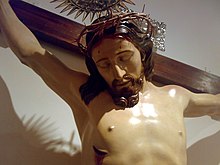
Wood carving has been extremely widely practiced, but survives much less well than the other main materials, being vulnerable to decay, insect damage, and fire. It therefore forms an important hidden element in the art history of many cultures.[3] Outdoor wood sculpture does not last long in most parts of the world, so that we have little idea how the totem pole tradition developed. Many of the most important sculptures of China and Japan in particular are in wood, and the great majority of African sculpture and that of Oceania and other regions.
Wood is light, so suitable for masks and other sculpture intended to be carried, and can take very fine detail. It is also much easier to work than stone. It has been very often painted after carving, but the paint wears less well than the wood, and is often missing in surviving pieces. Painted wood is often technically described as "wood and polychrome". Typically a layer of gesso or plaster is applied to the wood, and then the paint is applied to that.
Soft materials
Three dimensional work incorporating unconventional materials such as cloth, fur, plastics, rubber and nylon, that can thus be stuffed, sewn, hung, draped or woven, are known as soft sculptures. Well known creators of soft sculptures include Claes Oldenburg, Yayoi Kusama, Eva Hesse, Sarah Lucas and Magdalena Abakanowicz.[15]
Social status of sculptors
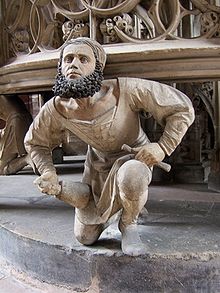
Worldwide, sculptors have usually been tradespeople whose work is unsigned; in some traditions, for example China, where sculpture did not share the prestige of
From the High Renaissance artists such as Michelangelo, Leone Leoni and Giambologna could become wealthy, and ennobled, and enter the circle of princes, after a period of sharp argument over the relative status of sculpture and painting.[18] Much decorative sculpture on buildings remained a trade, but sculptors producing individual pieces were recognised on a level with painters. From the 18th century or earlier sculpture also attracted middle-class students, although it was slower to do so than painting. Women sculptors took longer to appear than women painters, and were less prominent until the 20th century.
Anti-sculpture movements
History
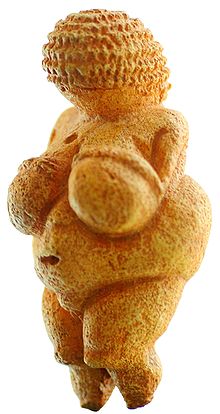
Prehistoric periods
Europe
The earliest undisputed examples of sculpture belong to the
The 30 cm tall
Much surviving
With the beginning of the
Ancient Near East
From the
-
Swimming Reindeer c. 13,000 BP, female and male swimming reindeer – late Magdalenian period, found at Montastruc, Tarn et Garonne, France
-
Şanlıurfa Museum; sandstone, 1.80 meters, c. 9,000 BCE
-
AJōmon dogūfigure, 1st millennium BCE, Japan
-
The Trundholm sun chariot, perhaps 1800–1500 BCE; this side is gilded, the other is "dark".
Ancient Near East

The
From the many subsequent periods before the ascendency of the
The conquest of the whole of Mesopotamia and much surrounding territory by the Assyrians created a larger and wealthier state than the region had known before, and very grandiose art in palaces and public places, no doubt partly intended to match the splendour of the art of the neighbouring Egyptian empire. Unlike earlier states, the Assyrians could use easily carved stone from northern Iraq, and did so in great quantity. The Assyrians developed a style of extremely
-
The Guennol Lioness, 3rd millennium BCE, 3.25 inches (8.3 cm) high
-
One of 18 Statues of Gudea, a ruler around 2090 BCE
-
TheOld Babylonian, around 1800 BCE
-
Part of the Lion Hunt of Ashurbanipal, c. 640 BCE, Nineveh
Ancient Egypt
The
Egyptian
-
Facsimile of the Narmer Palette, c. 3100 BCE, which already shows the canonical Egyptian profile view and proportions of the figure
-
Menkaura(Mycerinus) and queen, Old Kingdom, Dynasty 4, 2490–2472 BCE. The formality of the pose is reduced by the queen's arm round her husband
-
Wooden tomb models, Dynasty XI; a high administrator counts his cattle
-
Tutankhamun's mask, c. late Eighteenth dynasty, Egyptian Museum
-
Osiris on a lapis lazuli pillar in the middle, flanked by Horus on the left, and Isis on the right, 22nd dynasty, Louvre
-
TheEgyptian Museum, Cairo
-
Late Period, c. 650–633 BCE, Cabinet des Médailles
Europe
Ancient Greece
The first distinctive style of
The subsequent Minoan and Mycenaean cultures developed sculpture further, under influence from Syria and elsewhere, but it is in the later Archaic period from around 650 BCE that the kouros developed. These are large standing statues of naked youths, found in temples and tombs, with the kore as the clothed female equivalent, with elaborately dressed hair; both have the "archaic smile". They seem to have served a number of functions, perhaps sometimes representing deities and sometimes the person buried in a grave, as with the Kroisos Kouros. They are clearly influenced by Egyptian and Syrian styles, but the Greek artists were much more ready to experiment within the style.
During the 6th century Greek sculpture developed rapidly, becoming more naturalistic, and with much more active and varied figure poses in narrative scenes, though still within idealized conventions. Sculptured
-
Cycladic statue 2700–2300 BCE. Head from the figure of a woman, H. 27 centimetres (11 in)
-
Cycladic Female Figurine, c. 2500–2400 BCE, 41.5 cm (16.3 in) high
-
Mycenae, 1600−1500 BCE. Silver rhyton with gold horns and rosette on the forehead
-
Late Archaic warrior from the east pediment of theTemple of Aphaea, c. 500
-
The Amathus sarcophagus, from Amathus, Cyprus, 2nd quarter of the 5th century BCE Archaic period, Metropolitan Museum of Art
Classical
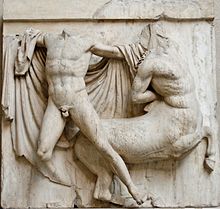
There are fewer original remains from the first phase of the Classical period, often called the Severe style; free-standing statues were now mostly made in bronze, which always had value as scrap. The Severe style lasted from around 500 in reliefs, and soon after 480 in statues, to about 450. The relatively rigid poses of figures relaxed, and asymmetrical turning positions and oblique views became common, and deliberately sought. This was combined with a better understanding of anatomy and the harmonious structure of sculpted figures, and the pursuit of naturalistic representation as an aim, which had not been present before. Excavations at the Temple of Zeus, Olympia since 1829 have revealed the largest group of remains, from about 460, of which many are in the Louvre.[48]
The "High Classical" period lasted only a few decades from about 450 to 400, but has had a momentous influence on art, and retains a special prestige, despite a very restricted number of original survivals. The best known works are the
The High Classical style continued to develop realism and sophistication in the human figure, and improved the depiction of drapery (clothes), using it to add to the impact of active poses. Facial expressions were usually very restrained, even in combat scenes. The composition of groups of figures in reliefs and on pediments combined complexity and harmony in a way that had a permanent influence on Western art. Relief could be very high indeed, as in the Parthenon illustration below, where most of the leg of the warrior is completely detached from the background, as were the missing parts; relief this high made sculptures more subject to damage.[50] The Late Classical style developed the free-standing female nude statue, supposedly an innovation of Praxiteles, and developed increasingly complex and subtle poses that were interesting when viewed from a number of angles, as well as more expressive faces; both trends were to be taken much further in the Hellenistic period.[51]
Hellenistic
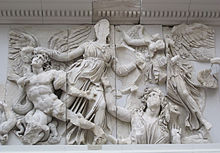

The
Hellenistic sculpture greatly expanded the range of subjects represented, partly as a result of greater general prosperity, and the emergence of a very wealthy class who had large houses decorated with sculpture, although we know that some examples of subjects that seem best suited to the home, such as children with animals, were in fact placed in temples or other public places. For a much more popular home decoration market there were Tanagra figurines, and those from other centres where small pottery figures were produced on an industrial scale, some religious but others showing animals and elegantly dressed ladies. Sculptors became more technically skilled in representing facial expressions conveying a wide variety of emotions and the portraiture of individuals, as well representing different ages and races. The reliefs from the Mausoleum are rather atypical in that respect; most work was free-standing, and group compositions with several figures to be seen in the round, like the Laocoon and the Pergamon group celebrating victory over the Gauls became popular, having been rare before. The Barberini Faun, showing a satyr sprawled asleep, presumably after drink, is an example of the moral relaxation of the period, and the readiness to create large and expensive sculptures of subjects that fall short of the heroic.[54]
After the conquests of Alexander
-
TheRiace Bronzes, very rare bronze figures recovered from the sea, c. 460–430
-
Hermes and the Infant Dionysos, possibly an original by Praxiteles, 4th century
-
Two elegant ladies, pottery figurines, 350–300
-
Bronze Statuette of a Horse, late 2nd – 1st century BCE Metropolitan Museum of Art
-
Vatican Museum
-
Leochares, Apollo Belvedere, c. 130–140 CE. Roman copy after a Greek bronze original of 330–320 BCE. Vatican Museums
Europe after the Greeks
Roman sculpture
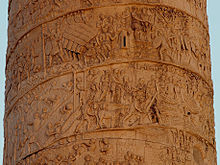

Early Roman art was influenced by the art of Greece and that of the neighbouring
A native Italian style can be seen in the tomb monuments, which very often featured portrait busts, of prosperous middle-class Romans, and portraiture is arguably the main strength of Roman sculpture. There are no survivals from the tradition of masks of ancestors that were worn in processions at the funerals of the great families and otherwise displayed in the home, but many of the busts that survive must represent ancestral figures, perhaps from the large family tombs like the Tomb of the Scipios or the later mausolea outside the city. The famous bronze head supposedly of Lucius Junius Brutus is very variously dated, but taken as a very rare survival of Italic style under the Republic, in the preferred medium of bronze.[59] Similarly stern and forceful heads are seen on coins of the Late Republic, and in the Imperial period coins as well as busts sent around the Empire to be placed in the basilicas of provincial cities were the main visual form of imperial propaganda; even Londinium had a near-colossal statue of Nero, though far smaller than the 30-metre-high Colossus of Nero in Rome, now lost.[60]
The Romans did not generally attempt to compete with free-standing Greek works of heroic exploits from history or mythology, but from early on produced historical works in relief, culminating in the great
After moving through a late 2nd-century "baroque" phase,[64] in the 3rd century, Roman art largely abandoned, or simply became unable to produce, sculpture in the classical tradition, a change whose causes remain much discussed. Even the most important imperial monuments now showed stumpy, large-eyed figures in a harsh frontal style, in simple compositions emphasizing power at the expense of grace. The contrast is famously illustrated in the Arch of Constantine of 315 in Rome, which combines sections in the new style with roundels in the earlier full Greco-Roman style taken from elsewhere, and the Four Tetrarchs (c. 305) from the new capital of Constantinople, now in Venice. Ernst Kitzinger found in both monuments the same "stubby proportions, angular movements, an ordering of parts through symmetry and repetition and a rendering of features and drapery folds through incisions rather than modelling... The hallmark of the style wherever it appears consists of an emphatic hardness, heaviness and angularity—in short, an almost complete rejection of the classical tradition".[65]
This revolution in style shortly preceded the period in which Christianity was adopted by the Roman state and the great majority of the people, leading to the end of large religious sculpture, with large statues now only used for emperors. However, rich Christians continued to commission reliefs for sarcophagi, as in the Sarcophagus of Junius Bassus, and very small sculpture, especially in ivory, was continued by Christians, building on the style of the consular diptych.[66]
-
Etruscan sarcophagus, 3rd century BCE
-
The "Capitoline Brutus", dated to the 3rd or 1st century BCE
-
Tomb relief of the Decii, 98–117 CE
-
Bust ofEmperor Claudius, c. 50 CE, (reworked from a bust of emperor Caligula), It was found in the so-called Otricoli basilica in Lanuvium, Italy, Vatican Museums
-
San Marco, Venice
-
The cameo gem known as the "Great Cameo of France", c. 23 CE, with an allegory of Augustus and his family
Early Medieval and Byzantine


The
-
Archangel Ivory, 525–550, Constantinople
-
Late Carolingian ivory panel, probably meant for a book-cover
Romanesque


Beginning in roughly 1000 A.D., there was a rebirth of artistic production in all Europe, led by general economic growth in production and commerce, and the new style of
Romanesque art was characterised by a very vigorous style in both sculpture and painting. The capitals of columns were never more exciting than in this period, when they were often carved with complete scenes with several figures.
Objects in precious materials such as ivory and metal had a very high status in the period, much more so than monumental sculpture — we know the names of more makers of these than painters, illuminators or architect-masons. Metalwork, including decoration in
The Cloisters Cross is an unusually large ivory crucifix, with complex carving including many figures of prophets and others, which has been attributed to one of the relatively few artists whose name is known, Master Hugo, who also illuminated manuscripts. Like many pieces it was originally partly coloured. The Lewis chessmen are well-preserved examples of small ivories, of which many pieces or fragments remain from croziers, plaques, pectoral crosses and similar objects.
-
The tympanum ofBurgundy, France, 1130s
-
Facade, Cathedral of Ourense 1160, Spain
-
Pórtico da Gloria,Cathedral of Santiago de Compostela, Galicia, Spain, c. 12th–13th centuries
Gothic
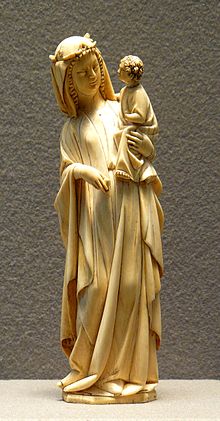
The Gothic period is essentially defined by Gothic architecture, and does not entirely fit with the development of style in sculpture in either its start or finish. The facades of large churches, especially around doors, continued to have large typanums, but also rows of sculpted figures spreading around them. The statues on the Western (Royal) Portal at Chartres Cathedral (c. 1145) show an elegant but exaggerated columnar elongation, but those on the south transept portal, from 1215 to 1220, show a more naturalistic style and increasing detachment from the wall behind, and some awareness of the classical tradition. These trends were continued in the west portal at Reims Cathedral of a few years later, where the figures are almost in the round, as became usual as Gothic spread across Europe.[72]
In Italy
Life-size tomb effigies in stone or
-
West portal of Chartres Cathedral (c. 1145)
-
South portal of Chartres Cathedral (c. 1215–1220)
-
West portal at Reims Cathedral, Annunciation group
-
The Bamberg Horseman 1237, near life-size stone equestrian statue, the first of this kind since antiquity.
-
Lid of the Walters Casket, with the Siege of the Castle of Love at left, and jousting. Paris, 1330–1350
-
Siege of the Castle of Love on a mirror-case in theLouvre, 1350–1370; the ladies are losing.
-
Central German Pietà, 1330–1340
-
David and a prophetfrom the Well of Moses
-
Base of the Holy Thorn Reliquary, a Resurrection of the Dead in gold, enamel and gems
-
Section of a panelled altarpiece withResurrection of Christ, English, 1450–1490, Nottingham alabasterwith remains of colour
-
Detail of the Last Supper from Tilman Riemenschneider's Altar of the Holy Blood, 1501–1505, Rothenburg ob der Tauber, Bavaria
Renaissance

Renaissance sculpture proper is often taken to begin with the famous competition for the doors of the
The period was marked by a great increase in patronage of sculpture by the state for public art and by the wealthy for their homes; especially in Italy, public sculpture remains a crucial element in the appearance of historic city centres. Church sculpture mostly moved inside just as outside public monuments became common. Portrait sculpture, usually in busts, became popular in Italy around 1450, with the Neapolitan Francesco Laurana specializing in young women in meditative poses, while Antonio Rossellino and others more often depicted knobbly-faced men of affairs, but also young children.[83] The portrait medal invented by Pisanello also often depicted women; relief plaquettes were another new small form of sculpture in cast metal.
Michelangelo was an active sculptor from about 1500 to 1520, and his great masterpieces including his
-
Florence Baptistry doors; oblique view here
-
Bargello Museum, Florence
-
Francesco Laurana, female bust (cast)
-
Mannerist
As in painting, early Italian
Small bronze figures for collector's cabinets, often mythological subjects with nudes, were a popular Renaissance form at which Giambologna, originally Flemish but based in Florence, excelled in the later part of the century, also creating life-size sculptures, of which two joined the collection in the Piazza della Signoria. He and his followers devised elegant elongated examples of the figura serpentinata, often of two intertwined figures, that were interesting from all angles.[88]
-
Primaticcio, who painted the oval inset, 1530s or 1540s
-
Perseus with the head of Medusa, 1545–1554
-
Giambologna, Samson Slaying a Philistine, about 1562
Baroque and Rococo
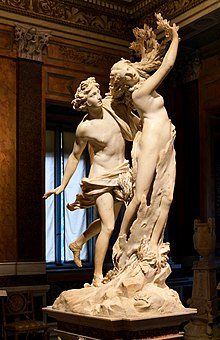
In Baroque sculpture, groups of figures assumed new importance, and there was a dynamic movement and energy of human forms— they spiralled around an empty central vortex, or reached outwards into the surrounding space. Baroque sculpture often had multiple ideal viewing angles, and reflected a general continuation of the Renaissance move away from the relief to sculpture created in the round, and designed to be placed in the middle of a large space—elaborate fountains such as Bernini's
The
-
Bust of Louis XIV, 1686, by Antoine Coysevox
-
Saint Veronica bySaint Peter's Basilica
-
Musée du Louvre
-
Nymphenburg Porcelaingroup
Neo-Classical
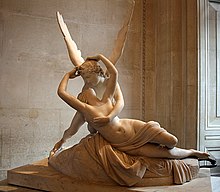
The
Asia
Greco-Buddhist sculpture and Asia
The origins of Greco-Buddhist art are to be found in the Hellenistic
-
Gandhara frieze with devotees, holdingSwat, Pakistan. Victoria and Albert Museum
-
Coin of Demetrius I of Bactria, who reigned circa 200–180 BCE and invaded Northern India
-
Stucco Buddha head, once painted, from Hadda, Afghanistan, 3rd–4th centuries
-
Gandhara Poseidon (Ancient Orient Museum)
-
Taller Buddha of Bamiyan, c. 547 CE, in 1963 and in 2008 after they were dynamited and destroyed in March 2001 by the Taliban
China
Native Chinese religions do not usually use cult images of deities, or even represent them, and large religious sculpture is nearly all Buddhist, dating mostly from the 4th to the 14th century, and initially using Greco-Buddhist models arriving via the Silk Road. Buddhism is also the context of all large portrait sculpture; in total contrast to some other areas, in medieval China even painted images of the emperor were regarded as private. Imperial tombs have spectacular avenues of approach lined with real and mythological animals on a scale matching Egypt, and smaller versions decorate temples and palaces.[97]
Small Buddhist figures and groups were produced to a very high quality in a range of media,
-
A bronze ding from late Shang dynasty (13th century–10th century BCE)
-
A tomb guardian usually placed inside the doors of the tomb to protect or guide the soul, Warring States period, c. 3rd century BCE
-
Gold stag with eagle's head, and ten further heads in the antlers. An object inspired by the art of the Siberian Altai mountain, possibly
-
Tomb figure of dancing girl,Han Dynasty(202 BCE—220 CE)
-
BronzeWestern Han
-
Northern Wei dynasty Maitreya(386–534)
-
Tang dynasty tomb figure in sancaiglaze pottery, horse and groom (618–907)
-
SeatedBuddha, Tang dynastyc. 650.
-
A wooden Bodhisattva from the Song dynasty (960–1279)
-
Chinese jade Cup with Dragon Handles, Song dynasty, 12th century
-
Blanc de Chine (Dehua porcelain), by He Chaozong, Ming dynasty, early 17th century
-
Blue underglaze statue of a man with his pipe, Jingdezhen porcelain, Ming Wanli period (1573–1620)
-
AChinese guardian lion outside Yonghe Temple, Beijing, Qing dynasty, c. 1694
Japan
Towards the end of the long Neolithic Jōmon period, some pottery vessels were "flame-rimmed" with extravagant extensions to the rim that can only be called sculptural,[103] and very stylized pottery dogū figures were produced, many with the characteristic "snow-goggle" eyes. During the Kofun period of the 3rd to 6th century CE, haniwa terracotta figures of humans and animals in a simplistic style were erected outside important tombs. The arrival of Buddhism in the 6th century brought with it sophisticated traditions in sculpture, Chinese styles mediated via Korea. The 7th-century Hōryū-ji and its contents have survived more intact than any East Asian Buddhist temple of its date, with works including a Shaka Trinity of 623 in bronze, showing the historical Buddha flanked by two bodhisattvas and also the Guardian Kings of the Four Directions.[104]
Jōchō is said to be one of the greatest Buddhist sculptors not only in Heian period but also in the history of Buddhist statues in Japan. Jōchō redefined the body shape of Buddha statues by perfecting the technique of "yosegi zukuri" (寄木造り) which is a combination of several woods. The peaceful expression and graceful figure of the Buddha statue that he made completed a Japanese style of sculpture of Buddha statues called "Jōchō yō" (Jōchō style, 定朝様) and determined the style of Japanese Buddhist statues of the later period. His achievement dramatically raised the social status of busshi (Buddhist sculptor) in Japan.[105]
In the
Almost all subsequent significant large sculpture in Japan was Buddhist, with some Shinto equivalents, and after Buddhism declined in Japan in the 15th century, monumental sculpture became largely architectural decoration and less significant.[107] However sculptural work in the decorative arts was developed to a remarkable level of technical achievement and refinement in small objects such as inro and netsuke in many materials, and metal tosogu or Japanese sword mountings. In the 19th century there were export industries of small bronze sculptures of extreme virtuosity, ivory and porcelain figurines, and other types of small sculpture, increasingly emphasizing technical accomplishment.
-
'Flame-style' vessel, Neolithic Jōmon period; c. 2750 BCE; earthenware with carved and applied decoration; height: 61 cm, diameter: 55.8 cm
-
Dogū with "snow-goggle" eyes, 1000–400 BCE
-
6th-century haniwa figure
-
Kongo Rishiki (Guardian Deity) at the Central Gate of Hōryū-ji
-
Tsubasword fitting with a "Rabbit Viewing the Autumn Moon", bronze, gold and silver, between 1670 and 1744
-
Izumiya Tomotada, netsuke in the form of a dog, late 18th century
-
Eagle by Suzuki Chokichi, 1892, Tokyo National Museum
Indian subcontinent

The first known
The pink sandstone Hindu,
-
The "Dancing Girl" of Mohenjo-daro, 3rd or 2nd millennium BCE (replica)
-
Buddha from Sarnath, 5th–6th century CE
-
The Colossaltrimurti at the Elephanta Caves
-
Rock-cut temples at Ellora
-
, 6th century
-
Hindu,Cholaperiod, 1000
-
Typical medieval frontal standing statue of Vishnu, 950–1150
-
Khajuraho Temple
-
Marble Sculpture of femaleyakshi in typical curving pose, c. 1450, Rajasthan
-
Thillai Nataraja Temple, Chidambaram, Tamil Nadu, densely packed with rows of painted statues
-
Sculpture of Guardian at the entrance of the Mandapam of Sri Jalagandeeswarar Temple, Vellore, Tamil Nadu
South-East Asia

The sculpture of the region tends to be characterised by a high degree of ornamentation, as seen in the great monuments of Hindu and Buddhist Khmer sculpture (9th to 13th centuries) at Angkor Wat and elsewhere, the enormous 9th-century Buddhist complex at Borobudur in Java, and the Hindu monuments of Bali.[115] Both of these include many reliefs as well as figures in the round; Borobudur has 2,672 relief panels, 504 Buddha statues, many semi-concealed in openwork stupas, and many large guardian figures.
In Thailand and Laos, sculpture was mainly of Buddha images, often gilded, both large for temples and monasteries, and small figurines for private homes. Traditional sculpture in Myanmar emerged before the Bagan period. As elsewhere in the region, most of the wood sculptures of the Bagan and Ava periods have been lost.
Traditional Anitist sculptures from the Philippines are dominated by Anitist designs mirroring the medium used and the culture involved, while being highlighted by the environments where such sculptures are usually placed on. Christian and Islamic sculptures from the Philippines have different motifs compared to other Christian and Islamic sculptures elsewhere. In later periods Chinese influence predominated in Vietnam, Laos and Cambodia, and more wooden sculpture survives from across the region.
-
Buddha from Borobudurtemple, Indonesia, c. 760–830
-
BronzeChaiya, Southern Thailand, Srivijayanart, c. 8th century
-
BronzeAvalokiteshvara from Bidor, Perak, Malaysia, c. 8th-9th century
-
The Anitist Agusan image from Agusan del Sur, Philippines, 9th-10th century
-
Khmer art, Cambodia, c. 800–875
-
Head of Jayavarman VII, Khmer art, Cambodia, c. late 12th century
-
An Islamic sculpture of a buraq, southern Philippines
-
Phra Achana, Wat Si Chum, Big Buddha image in Sukhothai, Thailand, c. 14th century
-
"the Buddha calling the earth to witness", The Buddha's hands are in the bhūmisparsa mudrā (subduing Māra) position. Ho Phra Kaeo temple, Vientiane, Laos
Islam

Figures of animals in the round were often acceptable for works used in private contexts if the object was clearly practical, so medieval Islamic art contains many metal animals that are
-
The Mshatta Facade, from a palace near Damascus, 740s
-
The Pisa Griffin, 107 cm high, probably 11th century
-
Part of a 15th-century ceramic panel fromarabesquebackground.
-
damascenedsteel inlaid with gold.
Africa
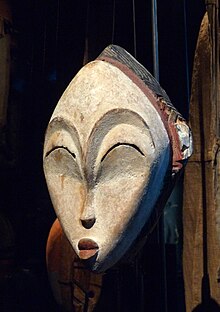
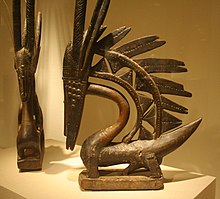
Historically, with the exception of some monumental Egyptian sculpture, most African sculpture was created in wood and other organic materials that have not survived from earlier than a few centuries ago; older pottery figures are found from a number of areas.
The
Many West African figures are used in religious rituals and are often coated with materials placed on them for ceremonial offerings. The Mande-speaking peoples of the same region make pieces of wood with broad, flat surfaces and arms and legs are shaped like cylinders. In Central Africa, however, the main distinguishing characteristics include heart-shaped faces that are curved inward and display patterns of circles and dots.
Populations in the African Great Lakes are not known for their sculpture.[118] However, one style from the region is pole sculptures, carved in human shapes and decorated with geometric forms, while the tops are carved with figures of animals, people, and various objects. These poles are, then, placed next to graves and are associated with death and the ancestral world. The culture known from Great Zimbabwe left more impressive buildings than sculpture but the eight soapstone Zimbabwe Birds appear to have had a special significance and were mounted on monoliths. Modern Zimbabwean sculptors in soapstone have achieved considerable international success. Southern Africa's oldest known clay figures date from 400 to 600 CE and have cylindrical heads with a mixture of human and animal features.
-
Nokterracotta, 6th century BCE–6th century CE
-
Ife head, terracotta, probably 12–14th centuries CE
-
Ife, Nigeria c. 12th century
-
Sculpture of a 'Queen Mother' from Benin, 16th century.
-
16th-century ivory mask from Benin
-
One of the Benin Bronzes, 16th–18th century, Nigeria.
-
Mask from Burkina Faso, 19th century
-
Mambilafigure, Nigeria
Ethiopia and Eritrea
The creation of sculptures in Ethiopia and
-
Stone statue fromAddi-Galamo, Tigray Province, 6th–5th century BCE
-
A jar spout from the early Kingdom of Aksum
-
The Obelisk of Axum, 4th century CE
-
A processional cross, Zagwe dynasty, 12th century
-
One of the seven life-sizeGebre Mesqel Lalibela)[123]
Sudan
In
-
A ceramic jug of the Kerma culture
-
A , 690–664 BCE
-
Column and elephant - part of the temple complex in Musawwarat es-Sufra, 3rd century BCE
-
Traces of paint on a relief depicting PrinceMeroitic period of the Kingdom of Kush, early 1st century CE
-
Relief of a ruler, aCandace of Meroë named Kandake Amanitore, 1st century CE
The Americas
Sculpture in present-day
Pre-Columbian
-
OlmecBaby Figure 1200-900 BCE
-
Olmec Jadeite Mask 1000–600 BCE
-
Olmec Colossal Head No. 3 1200–900 BCE
-
La Mojarra Stela 1 2nd century CE
-
Chalchiuhtlicue from Teotihuacán 200–500 CE
-
Teotihuacan mask 200–600 CE
-
Teotihuacan- Detail of the Temple of the Feathered Serpent 200–250 CE
-
A funerary urn in the shape of a "bat god" or a jaguar, Oaxaca, 300–650 CE
-
Moche portrait vessel with stirrup spout, Peru, 100 BCE–700 CE
-
K'inich Janaab Pakal I of Palenque, Maya, 603–683 CE
-
Ahkal Mo' Naab III Of Palenque, 8th century CE
-
Upakal K'inich 8th century CE, Palenque
-
Jaina Island type figure (Mayan) 650–800 CE
-
Classic Veracruz culture face 600–900 CE
-
Atlante from Tula, c. 1000 CE
-
Aztec (possibly) Mixtec, c. 1400–1521,
North America
In
The arrival of European Catholic culture readily adapted local skills to the prevailing
The history of
-
Gutzon Borglum and his son, Lincoln Borglum, Mount Rushmore, 1927–1941. L–R, George Washington, Thomas Jefferson, Theodore Roosevelt, and Abraham Lincoln.
-
Robert Gould Shaw Memorial by Augustus Saint-Gaudens, 1884–1897, plaster version
-
Abraham Lincoln (1920) in the Lincoln Memorial, Washington, D.C.
-
The K'alyaan Totem Pole of theTlingit Kiks.ádi Clan, erected at Sitka National Historical Park to commemorate the lives lost in the 1804 Battle of Sitka
-
Frederic Remington, The Bronco Buster, 1895, cast 1918. Metropolitan Museum of Art
-
Paul Manship, Dancer and Gazelles, 1916, Smithsonian American Art Museum, Washington, DC
-
Buffalo Bill - The Scout, 1924, commemorating Buffalo Bill in Cody, Wyoming
Moving toward modern art
19th–early 20th century, early Modernism and continuing realism
-
Jeanne d' Arc, 1852, Louvre
-
Alfred Gilbert, the so-called Eros, 1893, the world's first aluminium statue, Piccadilly Circus, London
-
Paul Gauguin, 1894, Oviri (Sauvage), partially glazed stoneware, 75 x 19 x 27 cm, Musée d'Orsay, Paris
-
Antoine Bourdelle, Day and Night, marble, 1903, Musée Bourdelle, Paris
-
Camille Claudel, The Waltz, 1905 cast of the second version
-
National Gallery in Prague
-
Aristide Maillol, The Night (La Nuit) 1909, Tuileries Garden, Paris
-
Robert Wlérick, The Thought 1933, Morez
Modern classicism contrasted in many ways with the classical sculpture of the 19th century which was characterized by commitments to naturalism (
Early masters of modern classicism included:
Classical training was rooted out of art education in Western Europe (and the Americas) by 1970 and the classical variants of the 20th century were marginalized in the history of modernism. But classicism continued as the foundation of art education in the Soviet academies until 1990, providing a foundation for expressive figurative art throughout eastern Europe and parts of the Middle East. By 2000, the European classical tradition retains a wide appeal to the public but awaits an educational tradition to revive its contemporary development.
Some of the modern classical became either more decorative/art deco (Paul Manship, Jose de Creeft, Carl Milles) or more abstractly stylized or more expressive (and Gothic) (Anton Hanak, Wilhelm Lehmbruck, Ernst Barlach, Arturo Martini)—or turned more to the Renaissance (Giacomo Manzù, Venanzo Crocetti) or stayed the same (Charles Despiau, Marcel Gimond).
Modernism
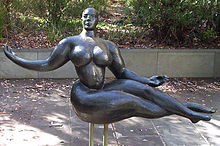

In the beginning of the 20th century,
Similarly, the work of Constantin Brâncuși at the beginning of the century paved the way for later abstract sculpture. In revolt against the naturalism of Rodin and his late-19th-century contemporaries, Brâncuși distilled subjects down to their essences as illustrated by the elegantly refined forms of his Bird in Space series (1924).[135]
Brâncuși's impact, with his vocabulary of reduction and abstraction, is seen throughout the 1930s and 1940s, and exemplified by artists such as
Modernist sculptors largely missed out on the huge boom in public art resulting from the demand for war memorials for the two World Wars, but from the 1950s the public and commissioning bodies became more comfortable with Modernist sculpture and large public commissions both abstract and figurative became common. Picasso was commissioned to make a maquette for a huge 50-foot (15 m)-high public sculpture, the so-called Chicago Picasso (1967). His design was ambiguous and somewhat controversial, and what the figure represents is not clear; it could be a bird, a horse, a woman or a totally abstract shape.
During the late 1950s and the 1960s abstract sculptors began experimenting with a wide array of new materials and different approaches to creating their work. Surrealist imagery, anthropomorphic abstraction, new materials and combinations of new energy sources and varied surfaces and objects became characteristic of much new modernist sculpture. Collaborative projects with landscape designers, architects, and landscape architects expanded the outdoor site and contextual integration. Artists such as Isamu Noguchi, David Smith, Alexander Calder, Jean Tinguely, Richard Lippold, George Rickey, Louise Bourgeois, Philip Pavia and Louise Nevelson came to characterize the look of modern sculpture.
By the 1960s
During the 1960s and 1970s figurative sculpture by modernist artists in stylized forms was made by artists such as Leonard Baskin, Ernest Trova, George Segal, Marisol Escobar, Paul Thek, Robert Graham in a classic articulated style, and Fernando Botero bringing his painting's 'oversized figures' into monumental sculptures.
Gallery of modernist sculpture
-
André Derain, Nu debout, 1907, limestone, Musée National d'Art Moderne
-
Henri Matisse, Figure décorative, 1908, bronze
-
Amedeo Modigliani, Female Head, 1911–12, Metropolitan Museum of Art
-
Joseph Csaky, Groupe de femmes (Groupe de trois femmes, Groupe de trois personnages), 1911–12, plaster, lost
-
Alexander Archipenko, La Vie Familiale (Family Life), 1912, destroyed
-
Constantin Brâncuși, Portrait of Mademoiselle Pogany, 1912, white marble; limestone block, Philadelphia Museum of Art. Exhibited at the 1913 Armory Show
-
Otto Gutfreund, Cellist, 1912–13
-
Marcel Duchamp, Fountain, 1917
-
Jacob Epstein, Day and Night, carved for the London Underground's headquarters, 1928.
-
Mieczysław Kotarbiński, Coat of arms of Poland, basalt relief in Art Deco style, Warsaw, 1931.
-
Käthe Kollwitz, The Grieving Parents, 1932, World War I memorial (for her son Peter), Vladslo German war cemetery
-
Jacques Lipchitz, Birth of the Muses, 1944–1950
-
Barbara Hepworth, Monolith-Empyrean, 1953
-
Washington, DC.
-
Henry Moore, Three Piece Reclining figure No.1, 1961, Yorkshire
-
Pablo Picasso, Chicago Picasso, 1967, Chicago, Illinois
-
New National Gallery, Berlin, Germany, Rickey is considered a Kinetic sculptor
-
Alexander Calder, Crinkly avec disc rouge, 1973, Schlossplatz, Stuttgart
-
Louise Nevelson, Atmosphere and Environment XII, 1970–1973, Philadelphia Museum of Art
-
Sir Anthony Caro, Black Cover Flat, 1974, steel, Tel Aviv Museum of Art
-
Joan Miró, Woman and Bird, 1982, Barcelona, Spain
Contemporary movements

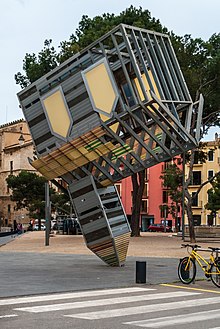
Palma de Mallorca, Plaça de la Porta de Santa Catalina
Also during the 1960s and 1970s artists as diverse as
Conceptual art is art in which the concept(s) or idea(s) involved in the work take precedence over traditional aesthetic and material concerns. Works include One and Three Chairs, 1965, is by Joseph Kosuth, and An Oak Tree by Michael Craig-Martin, and those of Joseph Beuys, James Turrell and Jacek Tylicki.
Minimalism
-
Tony Smith, Free Ride, 1962, 6'8 x 6'8 x 6'8 (the height of a standard US door opening), Museum of Modern Art, New York
-
Larry Bell, Untitled 1964, bismuth, chromium, gold, and rhodium on gold-plated brass; Hirshhorn Museum and Sculpture Garden
-
Cor-ten steel near Liverpool Street station, London
-
Donald Judd, Untitled, 1991, Israel Museum Art Garden, Jerusalem
Postminimalism
-
Richard Long, South Bank Circle, 1991 Tate Liverpool, England
-
Jean-Yves Lechevallier, Fettered wing. 1991
-
Anish Kapoor, Turning the World Upside Down, Israel Museum, 2010
-
Rachel Whiteread, Judenplatz Holocaust Memorial, Vienna, 2000
-
Guardians of Time,light sculpture by Manfred Kielnhofer at the Light Art Biennale Austria 2010
-
The Spire of Dublin officially titled the Monument of Light, stainless steel, 121.2 metres (398 feet), the world's tallest sculpture
Contemporary genres

Some modern sculpture forms are now practiced outdoors, as
Conservation

Sculptures are sensitive to environmental conditions such as
At any time many contemporary sculptures have usually been on display in public places; theft was not a problem as pieces were instantly recognisable. In the early 21st century the value of metal rose to such an extent that theft of massive bronze sculpture for the value of the metal became a problem; sculpture worth millions being stolen and melted down for the relatively low value of the metal, a tiny fraction of the value of the artwork.[142]
Form
Cultural
Method
Application
See also
Notes
- ^ en.museicapitolini.org Archived 2017-09-03 at the Wayback Machine (in Italian).
- ^ a b "Gods in Color: Painted Sculpture of Classical Antiquity" September 2007 to January 2008, The Arthur M. Sackler Museum Archived January 4, 2009, at the Wayback Machine
- ^ ISBN 978-0-521-28084-6
- ^ NGA, Washington Archived 2013-02-15 at the Wayback Machine feature on exhibition.
- Ptolemies began the Hellenistic tradition of ruler-portraits on coins, and the Romans began to show dead politicians in the 1st century BCE, with Julius Caesarthe first living figure to be portrayed; under the emperors portraits of the Imperial family became standard. See Burnett, 34–35; Howgego, 63–70.
- ^ "Article by Morris Cox". Archived from the original on August 28, 2008. Retrieved October 30, 2008.
- ^ Part of the Gods in Color exhibition. Harvard exhibition Archived 2014-10-06 at the Wayback Machine
- ^ Cook, 147; he notes that ancient Greek copyists seem to have used many fewer points than some later ones, and copies often vary considerably in the composition as well as the finish.
- ^ "Flash animation of the lost-wax casting process". James Peniston Sculpture. Archived from the original on September 14, 2010. Retrieved November 30, 2008.
- ^ Ravi, B. (2004). "Metal Casting – Overview" (PDF). Bureau of Energy Efficiency, India. Archived (PDF) from the original on February 7, 2016. Retrieved July 3, 2011.
- ^ "British Museum – The Lycurgus Cup". Archived from the original on November 4, 2015. Retrieved June 15, 2017.
- ISBN 978-0-9755383-0-2.)
{{cite book}}: CS1 maint: location missing publisher (link - ^ V&A Museum, Sculpture techniques: modelling in clay Archived August 2, 2012, at the Wayback Machine, accessed August 31, 2012.
- ^ Rawson, 140–44; Frankfort 112–13; Henig, 179–80.
- ISBN 978-0-7112-6465-6.
- ^ Rawson, 134–35.
- ^ Burford, Alison, "Greece, ancient, §IV, 1: Monumental sculpture: Overview, 5 c)" in Oxford Art Online, accessed August 24, 2012.
- ^ Olsen, 150–51; Blunt.
- ^ "Jewish virtual library, History of Jewish sculpture". Archived from the original on August 5, 2014. Retrieved August 20, 2014.
- ^ P. Mellars, Archeology and the Dispersal of Modern Humans in Europe: Deconstructing the Aurignacian, Evolutionary Anthropology, vol. 15 (2006), pp. 167–82.
- ISBN 978-92-3-102810-6.
- ISBN 978-0-7141-2333-2.
- ^ Sandars, 8–16, 29–31.
- ^ Hahn, Joachim, "Prehistoric Europe, §II: Palaeolithic 3. Portable art" in Oxford Art Online, accessed August 24, 2012; Sandars, 37–40.
- ISBN 978-0-495-57360-9.
- ^ Sandars, 75–80.
- ^ Sandars, 253−57, 183−85.
- ^ Frankfort, 24–37.
- ^ Frankfort, 45–59.
- ^ Frankfort, 61–66.
- ^ Frankfort, Chapters 2–5.
- ^ Frankfort, 110–12.
- ^ Frankfort, 66–74.
- ^ Frankfort, 71–73.
- ^ Frankfort, 66–74, 167.
- ^ Frankfort, 141–93.
- ^ Smith, 33.
- ^ Smith, 12–13 and note 17.
- ^ Smith, 21–24.
- ^ Smith, 170–78, 192–94.
- ^ Smith, 102–03, 133–34.
- ^ Smith, 4–5, 208–09.
- ^ Smith, 89–90.
- ^ images of Getty Villa 85.AA.103
- ^ Cook, 72, 85–109; Boardman, 47–59
- ^ "Research". Glyptoteket. Archived from the original on September 24, 2017. Retrieved September 23, 2017.
- ^ "Tracking Colour". www.trackingcolour.com. Archived from the original on December 9, 2017. Retrieved September 23, 2017.
- ^ Cook, 109–19; Boardman, 87–95.
- ^ Lapatin, Kenneth D.S., Phidias, Oxford Art Online, accessed August 24, 2012.
- ^ Cook, 119–31.
- ^ Cook, 131–41.
- ISBN 978-0-7538-2413-9.
- ^ Cook, 142–56.
- ^ Cook, 142–54.
- ^ Cook, 155–58.
- ^ Strong, 58–63; Hennig, 66–69.
- ^ Hennig, 24.
- Verres, former governor of Sicily, Cicero's prosecution details his depredations of art collections at great length.
- ^ Henig, 23–24.
- ^ Henig, 66–71.
- ^ Henig, 73–82; Strong, 48–52, 80–83, 108–17, 128–32, 141–59, 177–82, 197–211.
- ^ Henig, Chapter 6; Strong, 303–15.
- ^ Henig, Chapter 8.
- ^ Strong, 171–76, 211–14.
- ^ Kitzinger, 9 (both quotes), more generally his Ch 1; Strong, 250–57, 264–66, 272–80.
- ^ Strong, 287–91, 305–08, 315–18; Henig, 234–40.
- ^ Robinson, 12, 15.
- ^ Dodwell, Chapter 2.
- ^ Calkins, 79–80, 90–102.
- ^ Calkins, 107–14.
- ^ Calkins, 115–32.
- ^ Honour and Fleming, 297–300; Henderson, 55, 82–84.
- ^ Olson, 11–24; Honour and Fleming, 304; Henderson, 41.
- ^ Snyder, 65–69.
- ^ Snyder, 305–11.
- V&A Museumfeature on the Nottingham alabaster Swansea Altarpiece.
- ^ Calkins, 193–98.
- ^ Cherry, 25–48; Henderson, 134–41.
- ^ Olson, 41–46, 62–63.
- ^ Olson, 45–52, and see index.
- ^ Olson, 114–18, 149–50.
- ^ Olson, 149–50.
- ^ Olson, 103–10, 131–32.
- ^ Olson, Chapter 8, 179–81.
- ^ Olson, 179–82.
- ^ Olson, 183–87.
- ^ Olson, 182–83.
- ^ Olson, 194–202.
- Cornaro chapel; see index for Bernini generally.
- ^ Boucher, 16–18.
- ^ Honour and Fleming, 450.
- ^ Honour and Fleming, 460–67.
- ^ Boardman, 370–78; Harle, 71–84.
- ^ Boardman, 370–78; Sickman, 85–90; Paine, 29–30.
- ^ Rawson, Chapter 1, 135–36.
- ^ Rawson, 138–38.
- ^ Rawson, 135–45, 145–63.
- ^ Rawson, 163–65
- ^ Rawson, Chapters 4 and 6.
- ^ Rawson, 135.
- ^ a b Rawson, Jessica (1999). "Design Systems in Early Chinese Art". Orientations: 52. Archived from the original on October 18, 2020. Retrieved October 18, 2020.
- ^ a b "Shaanxi History Museum notice". Shaanxi History Museum. Archived from the original on January 14, 2021. Retrieved October 18, 2020.
- ^ Middle Jomon Sub-Period Archived 2009-05-25 at the Wayback Machine, Niigata Prefectural Museum of History, accessed August 15, 2012.
- ^ Paine & Soper, 30–31.
- ^ Kotobank, Jōchō. The Asahi Shimbun.
- ^ Kotobank, Kei school. The Asahi Shimbun.
- ^ Paine & Soper, 121.
- ^ Harle, 17–20.
- ^ Harle, 22–24.
- ^ a b Harle, 26–38.
- ^ Harle, 87; his Part 2 covers the period.
- ^ Harle, 124.
- ^ Harle, 301–10, 325–27
- ^ Harle, 276–84.
- ^ Honour & Fleming, 196–200.
- ^ Piotrovsky and Rogers, 23, 26–27, 33–37.
- ^ Piotrovsky and Rogers, 23, 33–37.
- ^ a b Honour & Fleming, 557.
- ^ Honour & Fleming, 559–61.
- ^ Honour & Fleming, 556–61.
- ^ De Lorenzi (2015), pp. 15–16.
- ^ Briggs (2015), p. 242.
- ^ a b Briggs (2015), p. 331.
- ^ Sobania (2012), p. 462.
- ^ a b Harkless (2006), p. 174.
- ^ "Nubian Art Archived 2018-05-28 at the Wayback Machine". Museum of Fine Arts, Boston. Accessed 28 May 2018.
- ^ Harkless (2006), pp. 174–75.
- ^ March 2011. "Nubia: Ancient Kingdoms of Africa Archived 2018-06-19 at the Wayback Machine". Institute for the Study of the Ancient World (New York University). Accessed May 28, 2018.
- ^ Castedo, Leopoldo, A History of Latin American Art and architecture, New York: Frederick A. Praeger, Publisher, 1969.
- ^ Honour & Fleming, 553–56.
- ^ Neumeyer, Alfred, The Indian Contribution to Architectural Decoration in Spanish Colonial America. The Art Bulletin, June 1948, Volume XXX, Number two.
- ISBN 0-19-513381-1.
- ^ Rodin to Now: Modern Sculpture Archived 2012-08-25 at the Wayback Machine, Palm Springs Desert Museum.
- ^ Curtis, Penelpoe, Taking Positions: Figurative Sculpture and the Third Reich, Henry Moore Institute, London, 2002.
- ISBN 978-0-8109-3934-9
- ISBN 978-0-19-512878-9
- ^ National Air and Space Museum Receives Ascent Sculpture for display at Udvar-Hazy Center [2][permanent dead link]
- ^ "NY Times, Umbrella Crushes Woman". The New York Times. October 28, 1991. Archived from the original on February 5, 2017. Retrieved February 18, 2017.
- ^ "Guggenheim museum". Archived from the original on January 4, 2013.
- ^ "Dia Foundation". Archived from the original on July 8, 2012. Retrieved August 27, 2012.
- ^ "Art Army by Michael Leavitt", hypediss.com[3] Archived 2015-11-18 at the Wayback Machine, December 13, 2006.
- ^ BBC: Barbara Hepworth sculpture stolen from Dulwich Park, 20 December 2011 Archived 10 November 2018 at the Wayback Machine. Example of theft of large bronze sculpture for the value of the metal.
References
- Boucher, Bruce, Italian Baroque Sculpture, 1998, Thames & Hudson (World of Art), ISBN 0-500-20307-5
- ISBN 0-19-881050-4
- ISBN 0-19-814386-9
- Briggs, Philip (2015) [1995]. Ethiopia. Chalfont St Peter: Bradt Travel Guides. ISBN 978-1-84162-922-3.
- Burnett, Andrew, Coins; Interpreting the Past, University of California/British Museum, 1991, ISBN 0-520-07628-1
- Calkins, Robert G.; Monuments of Medieval Art, Dutton, 1979, ISBN 0-525-47561-3
- Cherry, John. The Holy Thorn Reliquary, 2010, British Museum Press (British Museum objects in focus), ISBN 0-7141-2820-1
- ISBN 0-14-021866-1
- De Lorenzi, James (2015). Guardians of the Tradition: Historians and Historical Writing in Ethiopia and Eritrea. Rochester: University of Rochester Press. ISBN 978-1-58046-519-9.
- ISBN 0-7190-0926-X
- ISBN 0-14-056107-2
- Harkless, Necia Desiree (2006). Nubian Pharaohs and Meroitic Kings: The Kingdom of Kush. Bloomington, Indiana: AuthorHouse. ISBN 1-4259-4496-5.
- Harle, J. C., The Art and Architecture of the Indian Subcontinent, 2nd ed. 1994, Yale University Press Pelican History of Art, ISBN 0-300-06217-6
- Henderson, George. Gothic, 1967, Penguin, ISBN 0-14-020806-2
- Henig, Martin (ed.), A Handbook of Roman Art, Phaidon, 1983, ISBN 0-7148-2214-0
- ISBN 0-14-056108-0
- ISBN 0-333-37185-2
- Howgego, Christopher, Ancient History from Coins, Routledge, 1995, ISBN 0-415-08993-X
- ISBN 0-571-11154-8(US: Cambridge UP, 1977)
- Olson, Roberta J. M., Italian Renaissance Sculpture, 1992, Thames & Hudson (World of Art), ISBN 978-0-500-20253-1
- ISBN 978-0-7141-2446-9
- Piotrovsky, M. B., and J. M. Rogers (eds), Heaven on Earth: Art from Islamic Lands, 2004, Prestel, ISBN 3-7913-3055-1
- Robinson, James, Masterpieces of Medieval Art, 2008, British Museum Press, ISBN 978-0-7141-2815-3
- Sandars, Nancy K., Prehistoric Art in Europe, Penguin (Pelican, now Yale, History of Art), 1968 (nb 1st ed.; early datings now superseded)
- Scholten, Frits (2011). European sculpture and metalwork. New York: The Metropolitan Museum of Art. ISBN 978-1-58839-441-5.
- Sickman, Laurence, in: Sickman L., & A. Soper, "The Art and Architecture of China", Pelican History of Art, 3rd ed. 1971, Penguin (now Yale History of Art), LCCN 70-125675
- Simon, Joshua. Neomaterialism, Berlin: Sternberg Press, 2013, ISBN 978-3-943365-08-5
- Smith, W. Stevenson, and Simpson, William Kelly. The Art and Architecture of Ancient Egypt, 3rd ed. 1998, Yale University Press (Penguin/Yale History of Art), ISBN 0-300-07747-5
- ISBN 0-13-623596-4
- Sobania, Neal W. (2012), "Lalibela", in Akyeampong, Emmanuel; Gates, Henry Louis, Jr., Dictionary of African Biography, Oxford: Oxford University Press, p. 462, ISBN 978-0-19-538207-5.
- Sobania, Neal W. (2012). "Lalibela", in Akyeampong, Emmanuel; Gates, Henry Louis, Jr., Dictionary of African Biography. Oxford: Oxford University Press. ISBN 978-0-19-538207-5.
- Strong, Donald, et al., Roman Art, 1995 (2nd ed), Yale University Press (Penguin/Yale History of Art), ISBN 0-300-05293-6
- Williams, Dyfri. Masterpieces of Classical Art, 2009, British Museum Press, ISBN 978-0-7141-2254-0
External links
- Sculpture "hub" at the Victoria and Albert Museum
- Corning Museum of Glass
- Cass Sculpture Foundation Archived 2009-08-31 at the Wayback Machine, a charity dedicated to commissioning monumental sculpture.
- Chisholm, Hugh, ed. (1911). . Encyclopædia Britannica. Vol. 24 (11th ed.). Cambridge University Press. pp. 488–517.
- Current research on polychromy on ancient sculpture at the Ny Carlsberg Glyptotek Tracking Colour






























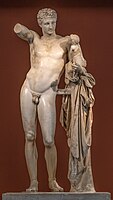
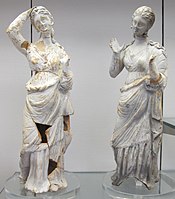
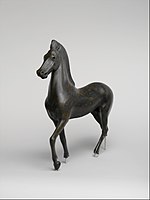
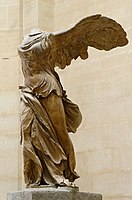


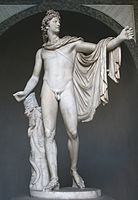

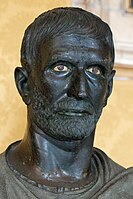







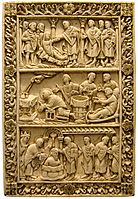

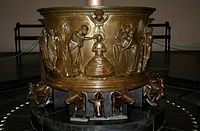
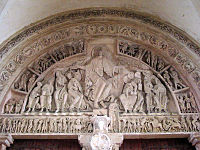





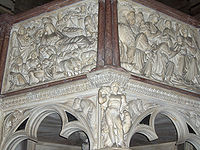

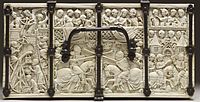

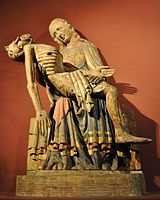









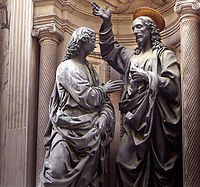
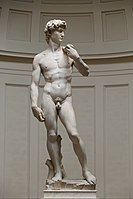

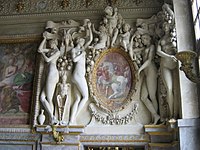

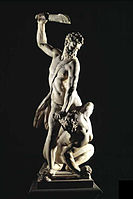
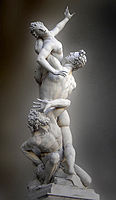





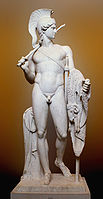
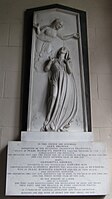










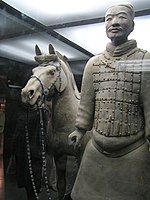
![Gold stag with eagle's head, and ten further heads in the antlers. An object inspired by the art of the Siberian Altai mountain, possibly Pazyryk, unearthed at the site of Nalinggaotu, Shenmu County, near Xi'an, China.[101] Possibly from the "Hun people who lived in the prairie in Northern China". Dated to the 4th-3rd century BCE,[101] or Han Dynasty period.[102] Shaanxi History Museum.[102]](http://upload.wikimedia.org/wikipedia/commons/thumb/c/cb/Gold_monster.jpg/182px-Gold_monster.jpg)






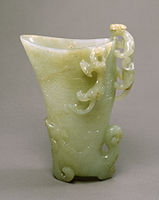


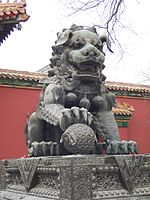
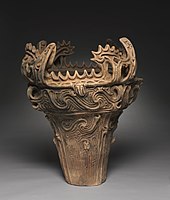
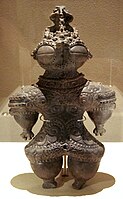


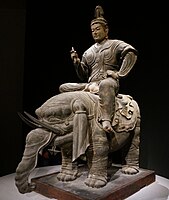


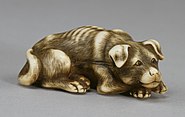

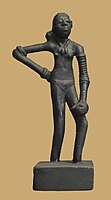


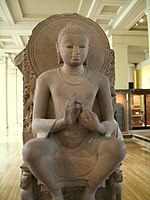


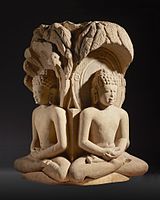



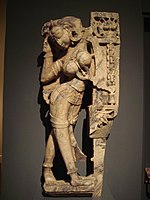
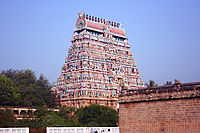
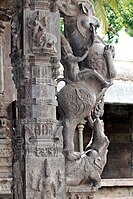







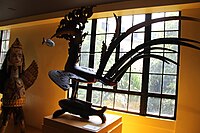
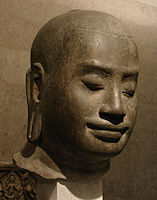
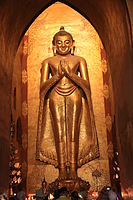


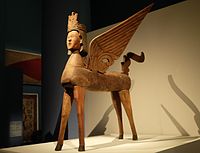
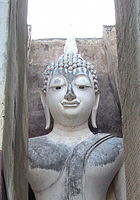
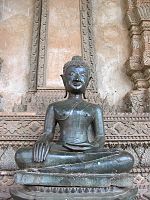

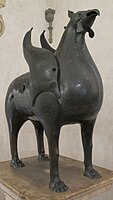
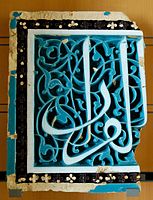

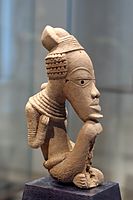
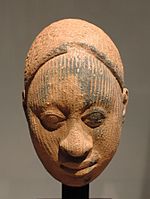


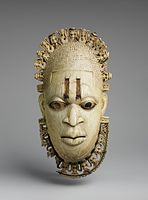



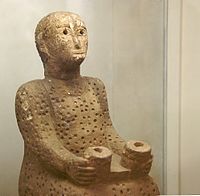



![One of the seven life-size saints carved into the wall of the Church of Bet Golgotha, Lalibela, 15th century (traditionally believed to have been made during the reign of Gebre Mesqel Lalibela)[123]](http://upload.wikimedia.org/wikipedia/commons/thumb/8/85/Bet_Golgotha.jpg/150px-Bet_Golgotha.jpg)


